

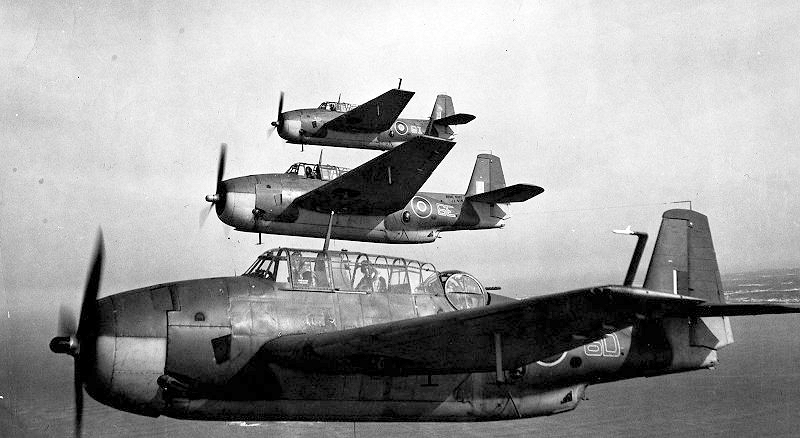
The Squadron was formed on the 4th of December 1943 at the United States Naval Air Station Squantum, near Boston in the USA. The Commanding Officer was Lt Cdr (A) N.G. Haigh RNVR, the Senior Observer Lt E. J. Treloar RN, and the Senior Pilot Lt (A) M.W.S. Jones RNVR. Only four of the other 19 squadron officers had had previous squadron experience. The others were pilots who had just completed their training with the US Navy at Pensacola and Fort Lauderdale, and observers who had recently finished their training in Trinidad (RNAS Piarco). The squadron complement also included 13 Telegraphist-Air-Gunners and a ground staff of 107 Petty Officers and ratings with an RAF Flight Sergeant in charge. The squadron took delivery of twelve new Grumman Avenger TBR Torpedo Bombers. The flying personnel were organised to form thirteen crews, twelve being assigned their own aircraft with one a spare crew.
The squadron flew for the first time on the 6th December 1943 and flew intensively during its 12-week stay at Squantum. The flying training embraced all the many aspects of the work of torpedo bomber reconnaissance squadrons. A total of 874 sorties were flown, including 162 at night. Flying time in excess of 1,250 hours was recorded. This was achieved in spite of intense cold which made it very difficult to start the engines. On occasions the sea in Boston Bay froze over. The only days when flying was not programmed in the 12 weeks were Christmas Day, New Year's Day and one Sunday. Part of the training was in deck landing, and during the work-up the squadron flew to Norfolk, Virginia, and all the pilots completed four deck landings each on the USS Charger in Chesapeake Bay. The squadron suffered casualties during the work-up. On only the second day of flying one aircraft crashed into the sea while carrying out a dummy torpedo attack in formation, and the crew of three were lost. Two other aircraft were damaged in other accidents. One was written off in a heavy landing at Squantumand another made a wheels-up landing, at night, on a frozen lake after loss of power due to carburettor icing.
At the end of the work-up the squadron moved to Vancouver, British Columbia, on the west coast of Canada, in preparation for embarking on an Escort Carrier. The aircraft flew to Vancouver following the normal aircraft ferry route, which was south to the Mexican border, through the Rocky Mountains and then up the west coast of America. A ground party travelled by train with the squadron stores. The flight to Vancouver, which started on the 1st March 1944, did not go smoothly. The first mishap occurred on the second day when the squadron landed at Shreveport, Louisiana. One aircraft was badly damaged on landing and a crew had to return to New York to obtain a replacement. The remaining 11 aircraft continued on the flight. The next problems arose at El Paso, Texas. Here one aircraft was found to have engine defects and another swerved off the runway into soft sand on take-off and was damaged. These aircraft were left to be repaired and to await the replacement aircraft from New York before continuing their flight. On the flight from Tucson one aircraft had to make a forced landing because of an oil leak, but this was corrected and the nine aircraft arrived safely at Los Angeles. On the flight from Los Angeles, however, another aircraft developed a defect and had to make a forced landing. Unfortunately, the emergency airfield used was extremely muddy and the aircraft and the other two in the sub-flight, which landed to give assistance, became bogged down. It was two days before the three aircraft were extricated from the mud and followed the others.
In the meantime the leading six aircraft had reached Redding, California, but had then become weather-bound. The three aircraft over flew Redding and the six on the ground took off without clearance to follow them. The nine aircraft were reunited at Portland, Oregon, and flew on together to Vancouver which they reached on the 10th March, nine days after they had started out from Squantum. The remaining three aircraft, the new one to replace the one written off at Shreveport and the two left at El Paso to be repaired, eventually arrived at Vancouver on the 19th. The ground party had arrived at Vancouver on the 4th of March after a gruelling four-day journey in which they had hardly left the train.
The squadron stayed ashore at the RCAF airfield at Sea Island for about four weeks, during which the aircraft were repaired from the ravages of the flight from Squantum and the crews prepared to fly on to HMS ARBITER which was in port at Vancouver.
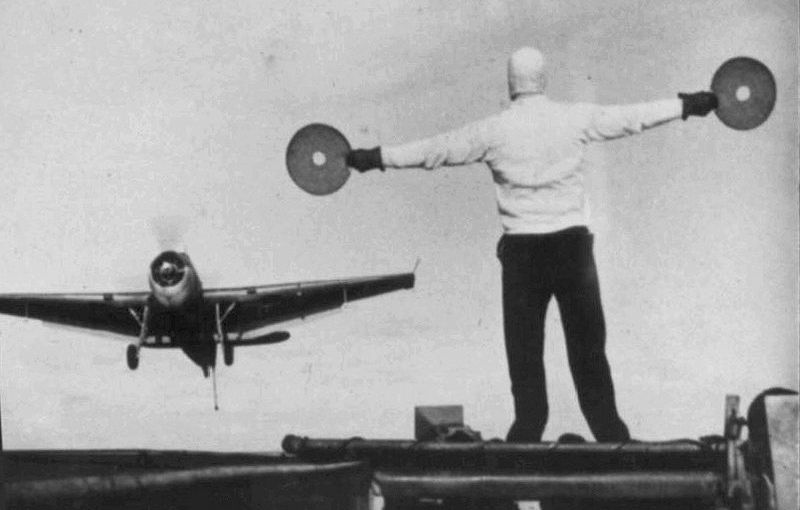
The squadron aircraft successfully landed-on HMS ARBITER on the 4/5th of April 1944. The ship then sailed for San Diego which it reached on the 9th. ARBITER put to sea on the 11th for flying exercises and squadron aircraft made 12 sorties without incident before flying was curtailed by high winds and the ship returned to San Diego on the 13th. ARBITER sailed for the Panama Canal on the 17th of April. During passage to Balboa flying was restricted by weather conditions, the wind being first too strong and then too weak. However, squadron aircraft made fourteen training sorties. Two accidents occurred during these. One aircraft crashed into the ship's 'island' when landing-on and another put a wheel into the port catwalk. Shortly before arriving at Balboa the ship's engines broke down and she had to be towed into port.
It took eight days to repair the ship's engines. When this had been done she passed through the Canal to Cristobal and sailed for Norfolk, Virginia. On passage to Norfolk the squadron resumed flying. After five training sorties had been flown the wind strength fell, and when aircraft were launched for a second exercise the second to take off stalled and crashed into the sea on the port side. The crew were rescued by the escort, USS REHOBARTH, but the observer was seriously injured. Flying was resumed on the following day, but after six training sorties had been completed the ship was found to have salt water in the boilers. The engines were stopped and she was towed into the US Navy base at Guantanamo Bay in Cuba. On the 15th of May, after the ship's engines had been repaired, she sailed for Norfolk but without an escort so no flying was possible. After a two-week stay in Norfolk, during which some of the squadron took leave, the ship sailed on to New York, arriving on the 31st.
In New York the ship took on a deck cargo of Corsairs which prevented any further flying. D-Day was spent in New York and on the 6th June 1944 the ship sailed in convoy for the UK, arriving at the King George V dock in Glasgow on the 20th of June.
The aircraft were unloaded by crane at the King George V dock and towed to the nearby Renfrew airfield, from where they were flown to RNAS Machrihanish. A ground party and stores were taken to Machrihanish by road. The squadron then went on fourteen days' leave. On return from leave on the 8th July 1944 the squadron moved temporarily to RNAS Maydown in Northern Ireland for an anti-U-boat course. This involved twelve days of morning lectures with flying in the afternoons and at night. Sixty training sorties were flown from Maydown. There was one accident, an aircraft landing with its wheels up. Damage was slight and there were no injuries.
On return to Machrihanish the squadron embarked upon an intensive programme of anti-submarine bombing, both by day and at night using flares to illuminate targets. Nearly 350 sorties were flown, 60 at night, without incident. During the stay at Machrihanish the squadron contributed to a flying programme arranged for the benefit of the First Lord of the Admiralty, and it was complemented for its formation flying and its air discipline. On the 29th of August the number of aircraft in the squadron was reduced to nine and three crews and their aircraft were transferred to other squadrons.
The squadron aircraft flew aboard HMS TRACKER on the 12 September 1944, a ground party with the stores having embarked the previous day, and on the 17th four Wildcats landed on to join the squadron. For three weeks the squadron flew intensively from TRACKER on a joint work-up programme with the ship. All pilots re-qualified at deck landing on the ship, both by day and at night. The emphasis was on anti-submarine exercises. Over one hundred and fifty training sorties were completed without major incident. The ship was twice visited by FOCT (Flag Officer, Carrier Training), Vice Admiral Lyster, and his staff to observe progress.
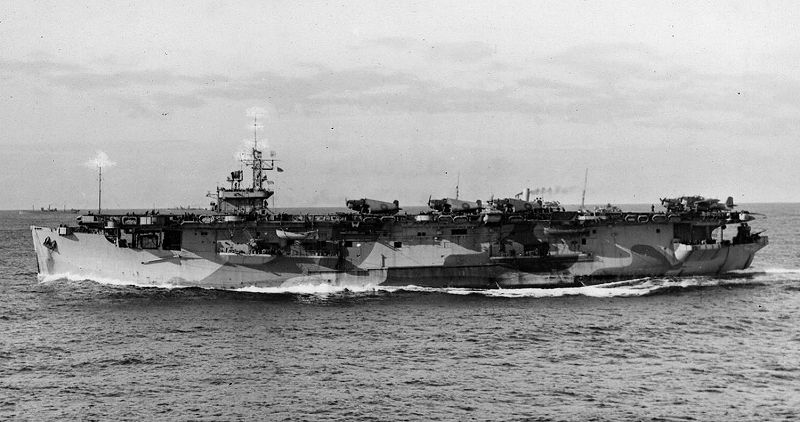
The work-up with the ship completed, and the squadron flew ashore to RNAS Machrihanish for further flying and for compass swinging and maintenance prior to final embarkation on the ship. The squadron's complement of aircraft was increased to eleven Avengers and five Wildcats. On the 14th of October the squadron flew back aboard HMS TRACKER off Holy Island and the ship sailed for Scapa Flow in company with carriers VINDEX and NAIRANA and screened by a surface escort. The squadron made its first operational sortie when an Avenger flew an anti U-boat patrol as the force sailed through the Minches.
TRACKER sailed from Scapa Flow on the 21st of October 1944 in company with VINDEX (811 Squadron), NAIRANA (835 Squadron) and the light cruiser DIDO to escort a convoy of merchant ships and submarine chasers to Murmansk. The convoy, which was joined on the 23rd, had a surface escort of five escort groups. The carriers took turns to be duty carrier, TRACKER with its Avengers covering the daylight hours from 0630 and the other carriers with Swordfish covering the hours of darkness. Normally two Avengers were maintained on patrol during duty periods, with Wildcats being scrambled to investigate radar contacts as they occurred.
On the 27th D/F bearings indicated that five U-boats were in the vicinity and three additional Avengers were launched on a close search. At 1118 one of 853's Avengers surprised a 510-ton U-boat on the surface. As the Avenger was armed with an acoustic homing depth charge it circled the U-boat and sent a sighting report. TRACKER turned into wind to launch its strike force of two Avengers and two Wildcats which were manned and at instant readiness on deck. However, when the sighting Avenger had completed one orbit of the U-boat it commenced to dive. The Avenger immediately dropped its homing depth charge ahead of the swirl left by the U-boat but the expected explosion did not occur. When the U-boat submerged the launch of the strike force was cancelled. The sighting Avenger marked the position and waited for the surface escort to arrive and take over the hunt. When the Avenger landed on it was found that the depth charge had been dropped "safe" because of a short circuit in the wiring of the arming device in the bomb bay.
TRACKER arrived in Kola Inlet leading to Murmansk on the 28th of October and anchored in Vaenga Bay. It remained there for four days. While it was in port the Red Navy Choir gave a concert in the ship's hangar to an audience from TRACKER and the escorts.
TRACKER sailed from the Kola Inlet on the 2nd of November to escort a homeward bound convoy. The squadron started to fly patrols immediately, three aircraft being maintained on patrol on the 3rd and fourteen sorties being flown during the day. Four aircraft landed on in the dark. One of the Avengers sighted a diving U-boat but it was not near enough to attack. The position was marked and the hunt taken over by surface escorts. There was insufficient wind to operate Avengers on two of the next five days, and on these TRACKER's turn as duty carrier was taken over by NAIRANA. On the other days TRACKER's Avengers flew eighteen patrols. One Wildcat was flown-off to investigate a bogey which proved to be an Avenger with a faulty IFF. The ship arrived at Scapa Flow on the 9th and then proceeded to the Clyde where it arrived on the 11th. The squadron then went on ten days' leave.
On return from leave the squadron left TRACKER, the aircraft flying off to RNAS Hatston, in the Orkneys, via Machrihanish. During its stay on TRACKER the squadron had made 136 deck landings, 19 of them at night.
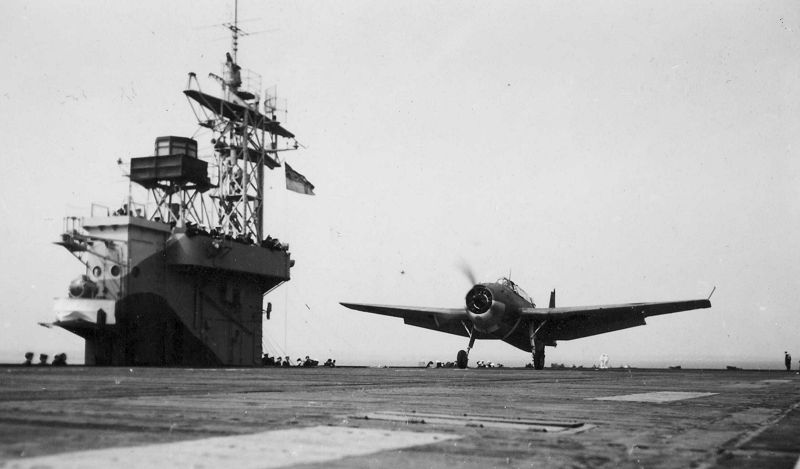
The squadron aircraft arrived at Hatston on the 4th of December 1944, and a ground party with the stores arrived two days' later after a gruelling journey. While at Hatston the squadron was granted ten days' leave with three days' travelling time. Half the squadron took the leave up to and including Christmas, and the other half took it in the New Year. During the stay at Hatston 132 training sorties were flown by the Avengers and Wildcats. Over the Christmas period U-boats were reported to be operating inshore, and the squadron Avengers flew 30 operational dawn and dusk patrols. Four Wildcats were loaned to HMS PREMIER to provide top cover for an operation inside the Norwegian minefields.
The Commanding Officer, Lt Cdr Haigh, was appointed CO of 765 Squadron NOTU (Naval Operational Training Unit) and Lt Cdr (A) J.M. Glaser was appointed as the new CO. The command was formally handed over on the 19th December. The new CO was an observer and an additional pilot was appointed to the squadron to compensate for this. On the 21st the squadron Avenger complement was reduced to eight. In the New Year a number of other changes in personnel were made with some officers being relieved from front line flying and others leaving for long training courses. Among those relieved from front line flying was the Senior Pilot. Lt Jones and his responsibilities were taken over by Lt Sailes.
On the 18th of January 1945 arrangements were put in hand for the squadron to embark on its next ship, HMS QUEEN, and a ground party with stores was embarked on the 21st. The eight Avengers were to fly to RNAS Ayr to fly on in the Firth of Clyde but the move was delayed by bad weather. Three Avengers flew to Ayr by the east coast route and arrived on the 24th but the others, flying by the west coast, were driven back by heavy snow storms and next day flew by the east coast as far as RNAS Arbroath. There they were joined by two Wildcats returning from a loan to HMS CAMPANIA. One of the Wildcats burst a tyre on landing at Arbroath and ended up in a six-foot snowdrift with severe damage to the undercarriage. The aircraft from Arbroath eventually arrived at Ayr on the 27th, where they joined up with those already there and flew aboard QUEEN.
Immediately on joining QUEEN the pilots re-qualified at deck landing and all the Avenger pilots completed four night landings each. The usual anti-U-boat exercises were then carried out, supplemented by simulated torpedo attacks on the ship by Avengers, and the Wildcats made interceptions. FOCT was flown aboard to witness the exercises. Later a further series of training sorties was flown with the emphasis on mine laying. Many of the flights were at night and they included boosted take-offs in the dark. All told 77 sorties were flown by Avengers in this part of the work-up. In addition 29 Wildcat sorties were also flown on a variety of exercises. In the course of these one Wildcat was lost overboard. The tie-back ring broke prematurely when the aircraft was being boosted and the aircraft trickled over the bow into the sea. The pilot was picked up uninjured.
On the 15th of February FOCT was flown aboard again to witness a simulated mine laying operation. That night 6 Avengers were launched, simulated laying mines between the Isle of Man and Calf of Man and were recovered. At the conclusion of this exercise the squadron went on ten days' leave.
The squadron resumed flying from QUEENon return from leave with newly joined pilots doing deck landings. In the course of these one Wildcat missed all the wires and crashed into the barriers. There were no casualties. Twelve Avenger training sorties were also flown. QUEEN sailed for Scapa Flow on the 2nd March 1945 and squadron Avengers flew six patrols on passage. Three Wildcats flew onto the ship in the Flow, bringing the Squadron complement to nine Avengers and eight Wildcats. The new Wildcat pilots carried out qualifying deck landings. With QUEEN operating within the Flow, 33 Avenger and 22 Wildcat training sorties were flown including formation mine laying exercises, escorts and interceptions.
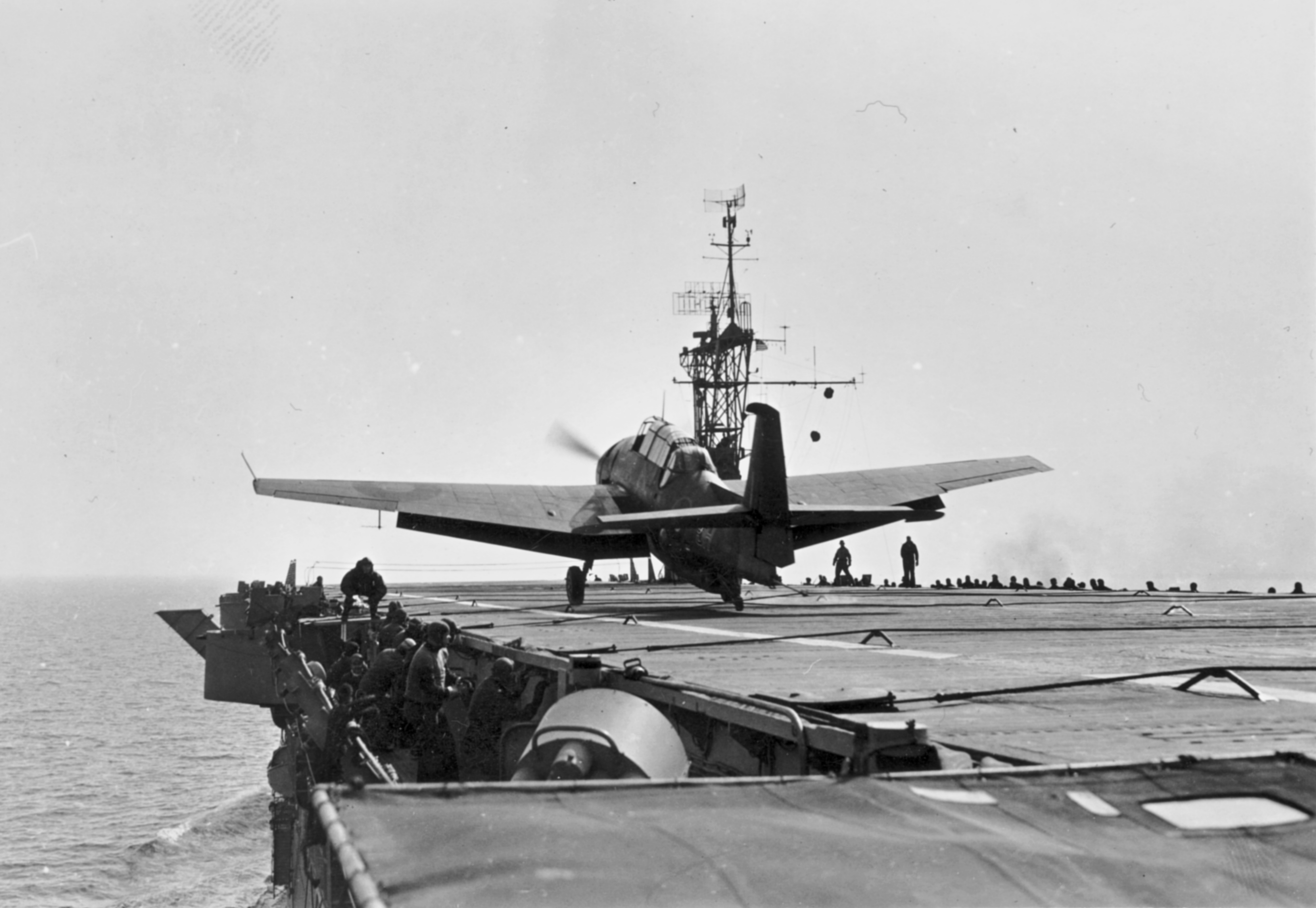
On the 19th March 1945 HMS QUEEN sailed from Scapa Flow in company with PREMIER, SEARCHER, the light cruiser BELLONA and a surface escort to take part in operation CUPOLA. The objective was for 846 Squadron Avengers on PREMIER to lay mines off the Norge Coast of Norway with 882 Squadron Wildcats from SEARCHER providing anti U-boat patrols and fighter cover for the carrier force. The operation was carried out on the 20th with the QUEEN launching two Avengers and two Wildcats. The weather deteriorated and when they were recovered the wind had reached 40 knots on the surface and 60 knots over the deck. Both the Wildcats were damaged on landing, one hitting the barrier and the other having its undercarriage collapse. One Avenger was diverted to PREMIER and burst both tyres on landing. The force returned to Scapa Flow on the 21st.
QUEEN sailed from Scapa Flow on the 24th March 1945 in company with BELLONA, DIDO, SEARCHER, NAIRANA, PUNCHER and with a surface escort, with the objective of striking at enemy shipping in the Norwegian Leads. Four squadron Wildcats were launched on the 24th to intercept a bogey but it proved friendly. Nine 853 Squadron Avengers were boosted off on the 26th armed with four 500lb bombs each. Flying at low level they made a landfall at Suven lighthouse and climbed to 4,000 feet to fly down the leads. Intelligence had indicated that two enemy convoys generally met east of the Island of Smolen at 1100 and the squadron was to bomb the northbound one. No shipping was sighted, however, and the alternative target of coastal guns and flak positions on the Island of Smolen could not be located either. The squadron jettisoned its bombs in the Leads before returning to the ship. Wildcats of the escort intercepted nine Me 109's which were climbing to intercept the Avengers, and claimed to have shot down three and damaged one.
853's Wildcats flew top cover for the carrier force. The ships stood off the coast on the 27th with the squadron's Avengers flying three patrols and its Wildcats being launched to intercept a bogey which proved friendly. On the 28th the ships closed the coast again and SEARCHER launched her Wildcats for an attack on Aasborg, Aalesund. The attack was cancelled. The carrier force returned to Scapa Flow on the 29th and all serviceable squadron aircraft were flown off to Hatston and a ground party was put ashore.
Between the 31st of March and the 4th April, the squadron Avengers flew 89 glide bombing practice sorties from Hatston, and the Wildcats flew 36 sorties, mainly on fighter direction exercises. On the 5th April the squadron aircraft flew back aboard QUEEN and the ground party was re-embarked. Two additional Wildcat pilots joined the squadron for the forthcoming operation.
QUEEN sailed from Scapa Flow again on the 6th April 1945 in company with the light cruisers BELLONA, BIRMINGHAM, PUNCHER, SEARCHER and TRUMPETER escorted by the 17th Destroyer Flotilla, all under the command of CS 1, Rear Admiral McGrigor. The squadron-maintained Avengers on stand-by on the 6th and 7th. No patrols were flown, but four Wildcats were flown as top cover for the force on the 6th. On the 8th nine Avengers were armed with four 500lb bombs each, but the weather deteriorated and the strike was postponed. On the 9th three Avengers were armed with depth charges and maintained at stand-by, but no patrols were flown. At the end of the day the aircraft were re-armed with bombs and on the 10th the ships closed the coast again. The weather remained bad, however, and at the end of the day operation ‘New market' was abandoned and the task force returned to Scapa Flow. QUEEN arrived at Scapa on the 14th of April and all the squadron aircraft flew ashore to Hatston and a ground party was disembarked.
From the 15th to the 26th April the squadron flew intensively from Hatston. Over 170 Avenger training sorties were flown, the vast majority of them glide bombing practice. One hundred Wildcat sorties were flown on a mix of section drill, air to air firing and fighter direction exercises. The ground party was re-embarked on the 27th and the aircraft took off to return to QUEEN in the Flow.
When the first Avenger, flown by the Senior Pilot with the CO as Observer, approached to land the ship was not quite into wind and the aircraft was waved off. The next two Avengers landed on and were struck down in the hangar and the next five were parked on deck forward of the barriers after landing. By then the first Avenger had gone around and made a new approach. It landed successfully and hooked a wire which was a signal to the flight deck crew to lower the barriers. Unfortunately the hook then pulled out of the aircraft and with the barriers lowered it careered down the deck to crash into the parked aircraft. All were seriously damaged but there were no injuries. It was the first time the aircraft had been deck landed since returning from a major overhaul.
It took an hour to clear the deck for all the remaining aircraft to be landed on. In the next two days the damaged aircraft were put over the side and replacement aircraft obtained and serviced ashore. The replacements landed-on on the 29th.
QUEEN sailed from Scapa on the 1st May 1945 in company with the heavy cruiser NORFOLK (Flying the Flag of Vice Admiral McGrigor CS 1), the light cruiser DIADEM, SEARCHER and TRUMPETER with seven escorts. On passage to the coast of Norway the squadron flew seven Avenger patrols and ten Wildcat sorties on section drills. On the 3rd two Avengers and a Wildcat were launched to investigate a contact but nothing was found.
On the 4th May 1945 eight squadron Avengers armed with four 500lb bombs each, were boosted off for a strike on Kilbotn U-boat harbour in the Lofoten islands. They were accompanied as close escort by four of the squadron Wildcats. A 9th Avenger went unserviceable due to an airlock in the fuel supply and had to be left behind. The strike force of forty-four aircraft also included Avengers of 846 Squadron from TRUMPETER and Wildcats of 882 squadron from SEARCHER.
The strike flew at low level until making landfall at Skoger. It then climbed to 4,000 feet, at which altitude the targets in Kilbotn Harbour were clearly visible. 846 Squadron had been assigned the Uboat depot ship Black Watch as its target and 853 a torpedo depot ship believed to be the Karl Von Herring but later identified as the Meteor. Wildcats from 882 Squadron were to bomb and strafe a flak ship, the ex-Norwegian cruiser Harald Haarflager, which was tied up at a pier some way from the other ships. The weather was very good with a little cloud to give some cover to the approaching aircraft. They encountered moderate heavy and light flak.
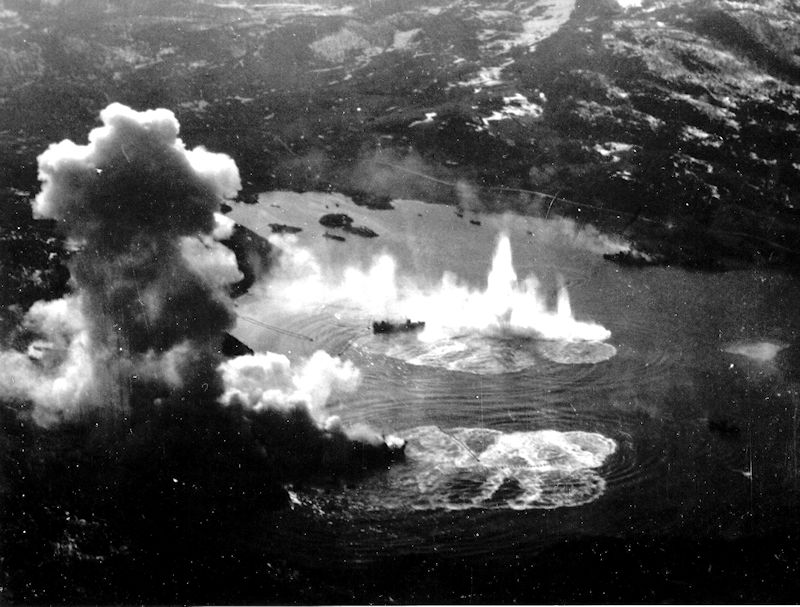
As the close escort fighter strafed the targets the Avengers peeled off in rapid succession to bomb them. The first 853 squadron aircraft to dive was QA, flown by Lieutenant Sailes with the CO as Observer. It received a direct hit in the port mainplane, probably by a 40mm shell, and was badly damaged. The Telegraphist/Air Gunner, CPO Astbury, was wounded by shrapnel, but the aircraft remained controllable and the attack was pressed home. The targets were rapidly obscured by smoke and spray making it difficult to observe hits. 'QF', flown by S/Lieutenant Gall, suffered an electrical failure and its bombs had to be dropped with the emergency release, resulting in an overshoot. The last 853 Avenger, piloted by S/Lieutenant Buchanan, finding the 853 target completely hidden, saw the Black Watch emerging from the smoke and spray and transferred his aim to this, scoring a direct hit which was followed shortly by a violent explosion. All 853 Squadron aircraft returned to the ship and landed on safely. One 846 Avenger and one Wildcat failed to return and were presumed to have been shot down by anti-aircraft fire. Photographs by the last aircraft to leave the scene showed both primary targets on fire with the Black Watch down by the stern. Reconnaissance later showed both had sunk. It was later learned that U 711 had been moored between the two depot ships and had also been sunk.
Four 853 Wildcats were flown-off as top cover and protection for the returning strike. The carrier force then set course for Scapa Flow, with QUEEN taking turns as duty carrier providing stand-by Avengers. On the 6th of May seven Wildcats were boosted-off for section drill and gunnery tracking exercises with the escort. In the course of the latter a Wildcat carried away the aerials of HMS ZAMBESI. Its hook and fuselage were damaged and it was diverted for an emergency landing at Sumburgh in the Shetlands.
While on passage for Scapa Flow the carrier, force was diverted to a position to the east of the Orkneys to prepare for Operation CLEAVER. To make room for more fighters three Avengers were flown ashore to Hatston, taking with them a number of pilots and observers who were being relieved from first line flying. Five additional Wildcats were flown on to QUEEN from CAMPANIA which had rendezvoused with the force. The changes resulted in an aircraft complement of six Avengers and twelve Wildcats.
On the 7th May 1945 QUEEN set course for the Skaggerak in company with Norfolk, (flying the flag of Vice Admiral McGrigor CS 1), SEARCHER and TRUMPETER and accompanied by seven escorts and an RFA. On the 8th May (VE DAY, but hostilities did not end until midnight) fighter and anti-submarine cover was given to minesweepers clearing a channel to Copenhagen for a force led by BIRMINGHAM to accept the surrender of the German ships there.
The squadron maintained two Avengers on patrol throughout the day, flying 12 sorties, and 18 Wildcat sorties were also flown. One Avenger fired a short burst at a Dornier flying boat. At the end of the day the force set course for Scapa Flow, arriving on the 10th. On the 11th Vice Admiral McGrigor and his staff came aboard and congratulated the aircrew who had taken part in Operation Judgement, which he stated had been a model operation in all respects. On the 13th the squadron sent representatives to a thanksgiving service on the nattleship RODNEY and to an assembly on TRUMPETER which was addressed by the First Lord of the Admiralty.
At Scapa Flow three Avengers were flown-on and five Wildcats flown off in preparation for escorting convoy JW 67 to Russia. Although the war in Europe had ended it was feared that some U-boats might not have heard of, or would not observe, the cease-fire. QUEEN sailed from Scapa Flow on the 14th of May 1945 in company with ORIBI and OFFA.
On the 15th it joined the convoy which consisted of twenty-six merchant ships with eleven escorts. Over the next six days 34 Avenger sorties were flown maintaining anti U-boat patrols up to 100 miles ahead of and around the convoy. The Wildcats also flew 22 sorties. In the course of these one Wildcat failed to catch a wire on landing and crashed into the ship's island. No one was injured.
The ship arrived in the Kola Inlet on the 20th and spent three days there, during which the Red Navy Choir gave a concert in the hangar and some of the crew of the Russian battleship ARCHANGEL (formerly HMS ROYAL SOVEREIGN) attended a screening of the film "Bathing Beauty."
QUEEN, with ONSLOW and OBDURAATE in company, sailed from the Kola Inlet on the evening of the 23rd May 1945, joining up with the convoy RA 67 with twenty-five merchant ships. On passage back to the UK 25 Avenger and 22 Wildcat sorties were flown. Increasingly the emphasis changed from patrolling to exercises in which Avengers made dummy attacks on the ships in the convoy while the Wildcats endeavoured to intercept them.
On arrival in the UK the squadron prepared to disband. Captain K.J. D'Arcy DSO RN addressed the officers and men of the squadron and congratulated them on the standard of efficiency maintained throughout their five months' stay on
QUEEN and praised the operational achievements, especially the attack on Kilbotn. The squadron aircraft flew off
QUEEN for the last time on the 30th May and flew over the ship in formation before flying ashore for the aircraft to be put in store and the crews to go on leave. The remainder of the squadron personnel stayed with the ship until it reached port and travelled on leave from there.
Squadron achievements
During its brief life of 18 months the Squadron: -
Flew over 5,000 hours,
Served in three carriers,
Escorted two convoys to Russia and back,
Sighted two U-boats, attacking one with an acoustic depth charge,
Took part in five operations against the enemy in Norway,
Flew nearly 300 operational sorties,
Made over 1,000 deck landings, 94 at night,
The landings resulted in only seven significant accidents, an accident rate of less than 1%.
Only two accidents occurred on take-off.
© 1999-2024 The Royal Navy Research Archive All Rights Reserved Terms of use Powered byW3.CSS
Comments (4)
My father N S Parish was a Navigator in the Avenger flown by Sub Lieutenant Buchanan and told me that they had a direct hit on the Black Watch. I have his Observer's Flying Log Book which has details about Operation Judgement. Fabulous History thanks so much.
My Brother, Charles Lawrence Kennett, was an armaments PO with the squadron on HMS Tracker escorting the Arctic Convoy RA 61 to Murmansk in October/November 1944. Would he have continued with the squadron on to the Queen? I think that he was also on the Arbiter. He had the France and Germany clasp to the Atlantic Star medal that makes me think that he was on the D-Day anti submarine protection operation. Can anyone confirm these possibilities?
Senior Pilot Lt (A) M.W.S. Jones RNVR was my father he passed in 2007 in Melbourne, Australia. I do have some squadron photo's I can send if you would like.
Great to find this information.
Lt CDR N.G Haigh was my Grandad! Its very cool reading up on what he was doing in the War :) He passed away in 2012 at 95 but had a great, long life, after the war he married Elizabeth Briggs they adopted two children and had my father and remained together till my Granny died exactly 6 months earlier before he died himself. Both were lovely parents and grandparents, I miss them!